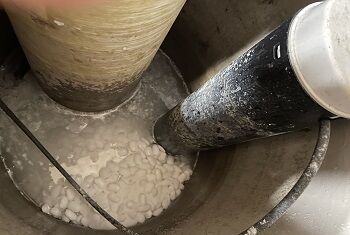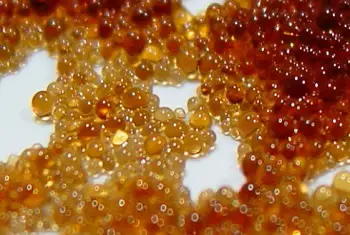You check your water softener’s brine tank regularly to make sure that you have sufficient salt in it. You see that the salt is low so you add salt to the tank and think, should I regenerate my water softener when I add salt to it?
You should regenerate your water softener after adding salt to the brine tank if the water softener has run out of salt. There is no need to manually regenerate a water softener each time you add salt unless the brine tank is empty.
If you top-off the salt in your water softener regularly and your water softener is providing you with soft water, your water softener will regenerate itself when it needs to.
But there are times when you may want to manually regenerate your water softener after adding salt to the brine tank.
Will I Get Soft Water If I Regenerate My Water Softener After Adding Salt?
If you are experiencing hard water from your water softener because your water softener ran out of salt, then you should get soft water back after you add salt to the brine tank and manually regenerate your water softener.
But regenerating your water softener immediately after adding salt to your empty brine tank will NOT properly regenerate your water softener because the salt needs time to dissolve in the water inside of your brine tank.
After adding salt to an empty brine tank, the water will start to dissolve the salt to create brine but this takes some time.
I recommend giving the salt about 2 hours to dissolve in your brine tank to allow it enough time to create a strong brine (Salt Solution) which is needed to regenerate the water softener resin which removes hardness from your water.
After at least two hours the brine should be strong enough to perform the ion exchange process which removes the existing hard minerals from the water softener resin so that it will be able to provide softened water.
Can I Regenerate My Water Softener When The Salt Is Low?

Typically, a water softener brine tank does not need to be filled in order to make the brine necessary for the water softener to soften your water.
As a rule of thumb, if you see salt within a few inches below the water level inside of your brine tank, the brine should still be strong enough for your water softener to regenerate its water softener resin.
If you look into the bottom of your brine tank and see nothing but water, that means that the water has dissolved all of the salt and could most likely dissolve more salt if it was available.
In other words, a strong brine is created when water in your water softener brine tank has dissolved as much salt as it can. If the water has dissolved all of the salt, the brine solution will most likely NOT be as strong as it should be.
Will Regenerating My Water Softener Without Salt Damage It?
It is VERY IMPORTANT to never let your water softener regenerate without salt in your brine tank.
Without salt in your water softener’s brine tank, your water softener will NOT be able to remove hard minerals that have collected on its water softener resin.
Hard minerals can build up on your water softener resin to the point where the resin can no longer be regenerated enough to soften your water.

Many water softeners run softened water through their control valves so that hard minerals do not build up in the internal parts of the valve which can cause excessive wear and tear to the water softener.
If your water softener regenerates without sodium that comes from the salt in your brine tank, hard minerals can clog openings inside of your water softener and cause moving parts to wear quicker.
How Much Salt Does A Water Softener Need To Regenerate?
A water softener only needs enough salt in its brine tank to create a brine solution strong enough for it to perform the ion exchange process which replaces hard minerals that have collected on the water softener resin.
The amount of resin contained in your water softener and the characteristics of your water affect how much brine will be needed to regenerate the water softener resin in your particular water softener.
But, if your water softener has been set correctly for your unique water characteristics (Hardness, Iron, and water usage for example), your water softener should only need enough salt to cover the water inside of the brine tank to ensure a strong enough brine for it to regenerate its water softener resin.

In many cases, one 40 pound bag of water softener salt will be enough for a residential water softener to regenerate its water softener resin at least one time.
Will My Water Softener Still Soften My Water Without Salt?
A water softener ONLY uses the salt in its brine tank when it regenerates its water softener resin.
Just because you don’t see any salt in your water softener’s brine tank does NOT mean that the water coming out of your water softener will be hard.
If your water softener has recently regenerated its water softener resin with the last of the salt that was in your brine tank, you should still have softened water coming from your water softener until the resin needs to be regenerated again.
In some cases, you could have soft water for a week, or in other cases, you may only have soft water for a day depending on the hardness of your water, the capacity of your water softener resin, and the amount of water that you use.
Either way, if your water softener resin tank has no salt left in it, get some more salt in it as A.S.A.P.
But just because your water softener brine tank is empty does NOT necessarily mean that you will have hard water.
To Sum Up!
If you add salt to your water softener brine tank while it still has some salt in it, you generally do NOT need to regenerate it after you add more salt to it.
If your water softener has run out of salt and you are getting hard water from your water softener, you may want to regenerate your water softener a few hours after you add salt to the brine tank in order to get softened water.


Hello. Today I added a bag of salt to my tank, it was less that 1/4 full. I then ran the regeneration process immediately after added the salt pellets. Since the regeneration, we now have very bubbly, kind of foamy water. Seems like it may be an issue of air getting in through the brine tube?
Could another regeneration, now that the new salt has had time to sit, possibly resolve this issue? Or is there a specific leak or valve issue I need to address? This is an older Morton SystemSaver softener for a residential home.
Thanks!
Hello Trevor and thank you for the question.
Bubbles can occur in a brine tank when you add salt because you stir up the water and the fresh salt can contain air that can escape when it enters the water.
Because you regenerated your water softener right after adding the salt, these air bubbles could have been drawn into the water softener but they should go away quickly and should not reoccur after future regenerations.
I hope this was helpful!
Paul